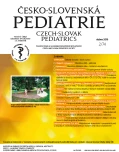The effect of nutrition on the development of obesity in different periods of childhood
Authors:
P. Tláskal
Authors‘ workplace:
Společnost pro výživu z. s
; Oddělení léčebné výživy FN Motol, Praha
Published in:
Čes-slov Pediat 2019; 74 (2): 88-92.
Category:
Overview
The author summarizes the data to different nutritional factors that affect the formation of adipose tissue. Not only excessive energy intake, but also differences of essential nutrients have their importance. The individual components of the nutrients is variously involved in metabolic processes. The formation of adipose tissue activates more diet with a higher content of sugars than other carbohydrates, diet with a higher content of saturated and monoenic unsaturated fatty acids than polyunsaturated omega 3 fatty acids.
In the context of the age is changing not only the way of nutrition, but also habits of the individual. In the diet is so the five time periods that are individually specific to activate the development of excessive accumulation of fat tissue. To prevent childhood obesity is necessary to pay attention to the child´s diet systematically and differentially.
Keywords:
obesity
Sources
- Zadák Z. Výživa v intenzivní péči. Praha: Grada Publishing, 2002 : 42–49.
- Ramdath DD, Wolver TMS, Siow YC, et al. Effect of processing on postprandial glycemic response and consumer acceptability of lentil-containing food items. Foods 2018 May 11; 7 (5).
- Bierman EL. Carbohydrates, sucrose and human diseases. Am J Nutr 1979; 32 : 2712–2722.
- Kolektiv autorů DACH. Referenční hodnoty pro příjem živin. 1. vyd. Praha: Výživaservis s.r.o., 2011 : 40–47.
- Couet C, Delarue J, Ritz P, et al. Effect of dietary fish oil on body fat mass and basal fat oxidation in healthy adults. Int J Obes Relat Metab Disord 1997 Aug; 21 (8): 637–643.
- Expertise collective. Obésité – dépistage et prevention chez l´enfant. Paris: Inserm, 2000 : 131–163.
- Tláskal P, Hrstková H, Balíkova M, et al. Výživové doporučené dávky v realitě jídelníčků českých předškolních a školních dětí. Výživa a potraviny 2009; 6 : 91–94.
- Rolland-Cachera LM, Deheeger M. Influence of macronutrients on adiposity development: a follow up study of nutrition and growth from 10 months to 8 years of age. Int J Obes Relat Metab Disord 1995 Aug; 19 (8): 573–578.
- Hoppe C, Molgaard C, Thomsen BL, et al. Protein intake at 9 mo of age is associated with body size but not with body fat in 10-y-old Danish children. Am J Clin Nutr 2004 Mar; 79 (3): 494–501.
- Günther AL, Buyken AE, Kroke E. The influence of habitual protein intake in early childhood on BMI and age at adiposity rebound: results from the DONALD Study. Int J Obes (Lond) 2006 Jul; 30 (7): 1072–1079.
- Aller EE, Larsen TM, Claus H, et al. Weight loss maintenance in overweight subjects on ad libitum diets with high or low protein content and glycemic index: the DIOGENES trial 12-month results. Int J Obes (Lond) 2014 Dec; 38 (12): 1511–1517.
- Van Vught JAH, et al. Association between diatary protein and 6y change in body composition among normal and overweight 9y old boys and girl. ESPEN 2008, Italy.
- Leao AL, Santos LC. Micronutrient consumption and overweight: Is there a relationship? Rev Bras Epidemiol 2012 Mar; 15 (1): 85–95.
- Frey SK, Vogel S. Vitamin A metabolism and adipose tissue biology. Nutrients 2011 Jan; 3 (1): 27–39.
- Romahn A, Burmeister W. Körperzusammensetzung während der ersten zwei Lebensjahre, Bestimmungen mit der Kalium 40-Metode. Klin Pädiat 1977; 1891 : 29–45.
- Tláskal P, Krásničanová H. Der Einfluss der Frűhernährung von Säuglingen auf ihre spätere somatische Entwicklung. HOMO 1999; 50 (1): 1–13.
- Vignerová J, Humeníková L, Brabec M, et al. Long-term changes in body weight, BMI, and adiposity rebound among children and adolescents in the Czech. Econ Hum Biol 2007 Dec; 5 (3): 409–425.
- Meas HH, Neale MC, Eaves LI. Genetic and environmental factors in relative body weight and human adiposity. Behav Genet 1997 Jul; 27 (4): 325–351.
- Zenetti D, Tikkanen E, Gustafsson S, et al. Birthweight, type 2 diabetes mellitus, and cardiovascular disease: Addressing the Barker hypothesis with Mendelian randomization. Circ Genom Precis Med 2018 Jun; 11 (6): e002054.
- Von Kries R, Koletzko B, Sauerwald T, et al. Breast feeding and obesity: cross sectional study. BMJ 1999 Jul 17; 319 (7203): 147–150.
- Priego T, Sánchez J, et al. Influence of breastfeeding on blood-cell transcript-based biomarkers of health in children. Pediatr Obes 2014; 9 (6): 463-470.
- Levion BE. Synergy of nature and nurture in the development of childhood obesity. Int J Obes (Lond) 2009 Apr; 33 (Suppl 1): 53–56.
- Tláskal P, Kudlová E, Šebková A, et al. Analysis of the nutrition of Czech infants and toddlers. Ann Nutr Metab 2015; 67 (Suppl 1): S116.
- Nishida C, Martinez Nocito F. FAO/WHO Scientific Update on carbohydrates in human nutrition: introduction. Eur J Clin Nutr 2007 Dec; 61 (Suppl 1): S1–S4.
- Swinburn BA, Caterson I, Seidell JC, et al. Diet, nutrition and the prevention of excess weight gain and obesity. Public Health Nutr 2004 Feb; 7 (1A): 123–146.
Labels
Neonatology Paediatrics General practitioner for children and adolescentsArticle was published in
Czech-Slovak Pediatrics

2019 Issue 2
Most read in this issue
- Overweight and obesity among children aged 7–8: Results of the WHO project in Slovakia
- Obesity and hypertension in children
- Etiopathogenesis of childhood obesity
- Obezita v dětském věku – historie a současnost
